This was published 9 years ago
Gallipoli, Turkey: Anzac battlegrounds tour guide
Ahead of the Gallipoli centenary, Steve Meacham makes the pilgrimage with his two young sons.
By Steve Meacham
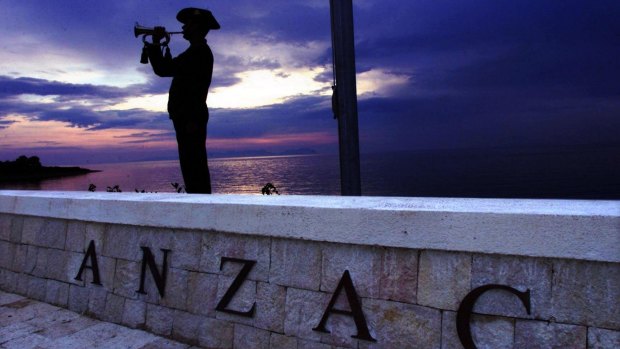
Poignant place: Australian Army bugler David Shadforth rehearses the Last Post at the new Anzac Commemorative Site.Credit: Mike Bowers
My two sons, aged 12 and 10, are picking up pebbles from the beach and flicking them into the pure blue waters of the Aegean, competing to see how many skips they can produce before the pebbles sink.
But this time their childhood contest carries an added poignancy. For we are standing at Anzac Cove. A century ago Australian men only a few years older than my sons were dying in their hundreds as they tried to secure this tiny toehold on the Gallipoli peninsula and so shorten "the Great War".
This morning Anzac Cove is virtually deserted. "The cove is much smaller than I thought," says my 12-year-old. "And those hills the Anzacs had to climb are much steeper than I imagined. How did they run up them?"
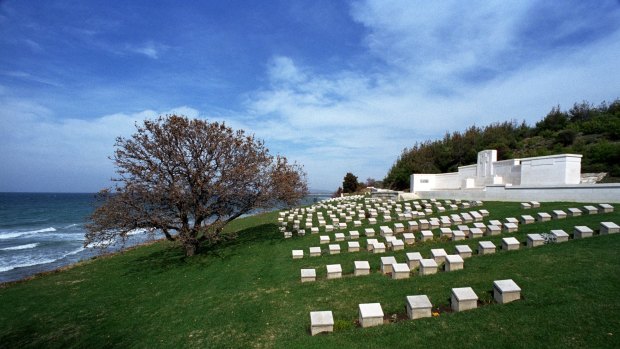
The Beach Cemetery.Credit: Alamy
Anyone who comes to Anzac Cove and stands at this spot looking up at those precipitous cliffs asks themselves the same question. You imagine yourself trying to ascend these pitiless hills, fractured with endless ravines, under relentless sniper and machinegun fire, and think – how far would I have got?
No matter how much you've read about Gallipoli, you can never really appreciate what those original diggers went through until you've been here and seen the diabolical landscape for yourself. The Anzacs weren't just beaten by the Turks, they were tortured by the topography.
An estimated 1.7 million people will visit Gallipoli in 1915, the centenary year. The majority, 1.4 million, will be Turks: this ground is sacred to them too.
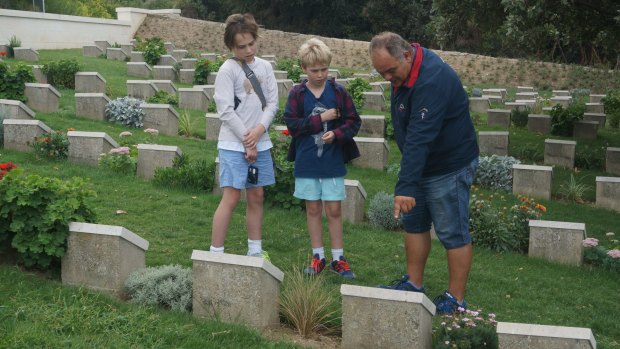
Guide Aykut tells Jake, 12, (left) and Sebbie, 10, the story of one of many Australians buried in a cemetery.Credit: Steve Meacham
Of the remaining 300,000 international visitors, most will be Australians and New Zealanders.
Only a lucky 10,500 people – 8000 Australians, 2000 New Zealanders and 500 VIPs including Prime Minister Tony Abbott and an unprecedented gathering of the royal family – are allowed to attend the dawn service on April 25.
Thousands more would love to join them. But only those who won tickets in the Australian and NZ national ballots will be allowed into the Gallipoli Peninsula Historic National Park on April 24 and 25.
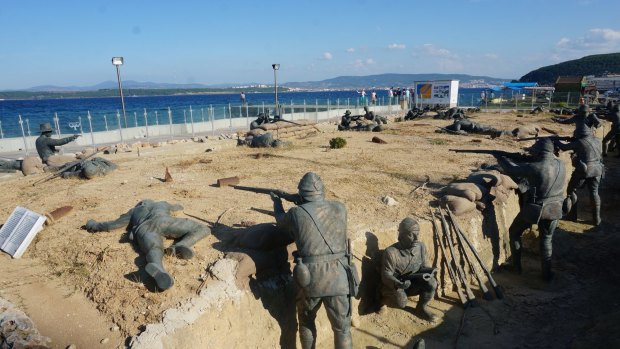
A sculpture in Eceabat portrays Australian and Turkish troops firing at each other from trenches.Credit: Steve Meacham
An additional 12,000 passengers will spend Anzac Day aboard the fleet of cruise ships visiting the peninsula next April, while countless others have booked local accommodation knowing they can visit the site either before or after Anzac Day (see separate story).
Because of the extraordinary interest, Australia's Department of Veterans' Affairs has also organised a separate ceremony on August 6 at the Lone Pine Memorial to mark the ill-fated August Offensive when thousands of Australian and New Zealand troops lost their lives in legendary battles such as Lone Pine, The Nek and Chunuk Bair.
However, I've brought my two young sons here a few months early. We were already planning a trip to Britain to visit family, so Gallipoli is a convenient, if unorthodox, stopover. And I've been told the best time to experience the true solemnity of the Gallipoli battlefields is outside the Anzac Day hustle and bustle.
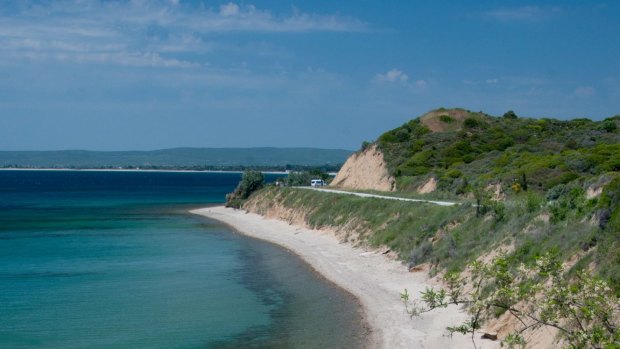
Site to remember: Anzac Cove.Credit: Alamy
Now, in the northern autumn, the temperatures are mild, the hotels only half full, and the museums and memorials uncrowded. Essentially we have the freedom to tour the Anzac battlegrounds at our own pace, diverting from the planned itinerary whenever we wish, without being forced along by time-pressed crowds.
We also get a fantastic opportunity to preview the improvements the Turkish government has made for the centenary. The most obvious is the new multimillion-dollar interpretive, interactive museum that has been built between Anzac Cove and the long winding road that follows the meandering fortunes of the 1915 frontline.
But there's a third reason we've come to Gallipoli now. I feel my sons are old enough to learn the truth. They've taken part in our local Anzac Day march, completed several primary school projects about WWI, and even been coerced into watching Peter Weir's 1981 movie ("It's mostly talking, dad," says the 10-year-old. "There's no action until the end, and then they all get killed.").
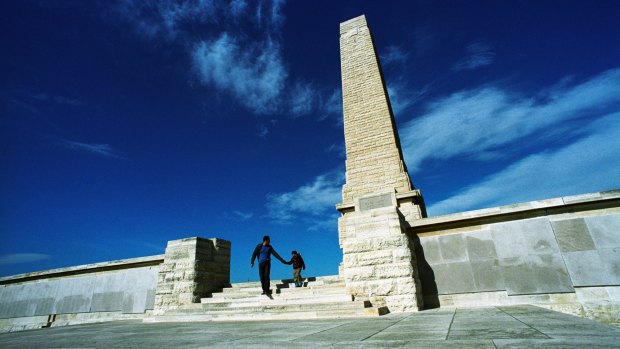
The Helles Memorial.Credit: Alamy
Given the kids' ages, I had erred on the side of caution, booking the Turkish section of our trip with one of Australia's leading battlefield tour specialists, Boronia Travel Centre, who often work with the Australian War Memorial.
They had recommended that we base ourselves at Eceabat, on the Gallipoli peninsula itself, rather than the much larger, more cosmopolitan city of Canakkale on the Asian side of the Dardanelles. That way we could avoid the 30-minute ferry ride twice a day. But if you are travelling with other adults, Canakkale with its wider choice of hotels and restaurants is probably the better bet.
Boronia had also arranged the services of Aykut Degre, our excellent English-speaking guide who is very good at tailoring his immense knowledge about the Gallipoli campaign to a schoolboy audience.
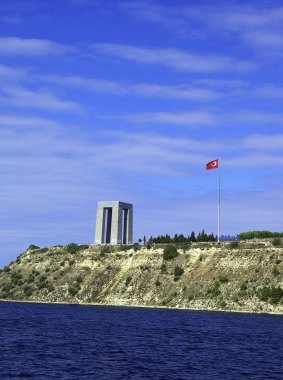
The Canakkale Martyrs Memorial.
Yet our Gallipoli experience had begun even before we'd met Aykut, almost as soon as we'd arrived in Eceabat after our five-hour coach trip from Istanbul. Our early evening stroll around the attractive little town, listening to the call to prayer from the local mosques, turned out to be a perfect educational primer.
Along the waterfront, the Turks have built an impressive display of statues, memorials and exhibits designed to explain the importance of what happened on the Gallipoli peninsula in 1915 to international visitors waiting for the ferry on their way to Troy and the holiday resorts of Bodrum and Izmir.
On this walk we first became acquainted with Corporal Seyit Cabuk, the Turkish equivalent of Simpson and his donkey – both of them unlikely folk heroes.
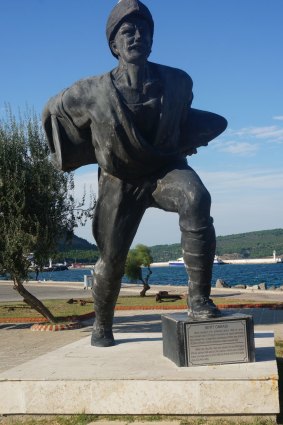
One of many statues of Turkish hero, Corporal Seyit Cabuk.Credit: Steve Meacham
On March 18, 1915 when the massive Allied fleet was attacking the Turkish forts guarding the entrance to the Dardanelles, Seyit conjured up superhuman strength he was never able to duplicate (it's a lighter shell he's carrying in the famous propaganda photos).
The massive gun he was serving at Mecidiye Fort remained operational, but its shell crane had been destroyed. According to legend, Seyit carried three artillery shells each weighing 215 kilograms up the steep metal stairs to load the gun and continue firing.
Again according to legend, one of those shells sank HMS Ocean and was a turning point in the war, although the less generous say the battleship hit a mine. Either way, there are statues of Corporal Seyit all over the Gallipoli peninsula. "Even though he was on the other team, Seyit was pretty epic," says my 10-year-old.
Aykut is impressed with our hastily acquired knowledge when we meet him for the first time at our hotel foyer at 8.30am. Twenty minutes later we've driven in our hire car to the western shores of the peninsula, having passed an open-air gozleme restaurant ("We love gozleme," says the 12-year-old of the Turkish crepes. "Good, because we are going there for lunch," Aykut says. "They make the best gozleme in all Turkey." Good. First battle won.)
First stop is Gaba Tepe. The beach here is wide, the route march eastwards to the Dardanelles over essentially flat terrain. No wonder the Turks and Germans had ensured it was heavily fortified.
Aykut explains all about that in front of a giant map of the battlefield. "There are four phases of the Gallipoli campaign," he says. "The first phase was the naval campaign to seize control of the Dardanelles. Westerners often forget that. But to we Turks, defeating the might of the Royal Navy and the French Navy was vitally important. That's why we celebrate Gallipoli every year on March 18, not April 25."
The British naval capitulation meant the Allies would have to resort to Plan B, landing ground troops on Gallipoli, seizing the peaks, storming the enemy gun emplacements, sweeping the mines and giving the all-clear to the battleships to sail north to Constantinople.
The three other chapters of the Gallipoli epic, Aykut continues, are the Allied landings in April 1915 and the subsequent trench war stalemate; the August Offensive by the Allies designed to break out of narrow confines and capture the Dardanelles; and – finally – the only part of the Allied strategy which went to plan – the evacuation of Gallipoli between December 1915 and January 1916.
Once the strategy has been explained to us, we drive 10 minutes north with an impending sense of doom, past Shrapnel Valley. Our second stop is Beach cemetery, where Simpson is buried, then on to Ari Burnu cemetery at the northern side of Anzac Cove. This is where the dawn ceremony of remembrance originally took place before the commemorations outgrew it and the "new" Anzac Commemorative Site was opened at nearby North Beach in 2000.
Aykut takes my boys on a tour of the gravestones, telling them the life stories of some of the men who are laid to rest here. The boys are particularly taken by memorial carrying the famous words of Kemal Ataturk, once Mustafa Kemal, the young defending general at Anzac and by 1934 (when the cemetery was taken over the Commonwealth War Graves Commission) the first president of the Turkish Republic:
"You, the mothers who sent their sons from far away countries, wipe away your tears. Your sons are now living in our bosom and are in peace, after having lost their lives on this land they have become our sons as well."
"That was very kind of him," says my 10-year-old. "He needn't have said that. The Anzacs were trying to invade his country."
Another five-minute drive and we're at North Beach, posing for photographs at the Anzac Commemorative Site, reading the interpretive panels, and looking up at the notorious landmarks that are deeply etched in Anzac legend: the Sphinx, Plugge's Plateau, Russell's Top.
Next we double back to the Gallipoli Kabatepe Museum, reopened at a cost of $80 million in 2012 and shaped like one of the battleships that first attacked the peninsula. For an hour or so, we're kept entertained as we walk through the 11 rooms which feature films and 3D effects relating the war from the Turkish point of view.
"It was very biased, wasn't it, dad?" says the 12-year-old. To a point son, but no more than the versions taught in Australian schools.
By now, we're hungry. So we head to the open air restaurant we'd seen earlier for three types of gozleme washed down with ayran, the salty yoghurt beverage which is a Turkish national drink.
Restored, we get back into the hire car and head up the loop road which links all the main Anzac frontline memorials. Lone Pine, now, is almost disconcertingly picturesque – an immaculate war garden that gives no hint of the carnage that took place here in August 1915.
At Johnston's Jolly, we get out to walk the opposing trenches, still visible despite the forest that has grown up around them. "I'm amazed the Turkish soldiers and the Anzacs were so close," says the 12-year-old.
He's equally staggered when we get to the ornate Turkish War Memorial. "Look, they're selling Vegemite toast! I can't believe you can get it here, but it shows how many Australians come to pay their respects."
At The Nek, Aykut retells the suicidal, pointless charge of the 3rd Light Horse Brigade on August 7, 1915, which forms the climax of the film Gallipoli. It was meant to be a diversion while fresh troops were landed at Suvla Bay to the north and attacked the Turks from the rear. We can see the salt lake at Suvla Bay from this narrow ridge - but Suvla, like so much else that happened at Gallipoli, was an Allied debacle.
Our last stop of the day is at the New Zealand war memorial on Chunuk Bair. Against amazing odds, Kiwi soldiers – supported by Gurkhas and British troops - succeeded in capturing the vital high ground during the August Offensive. For the first time since they landed on April 25, Anzac commanders could see the Dardanelles.
Had they managed to hold on to it, the whole history of Gallipoli might have ended differently. But on August 9, Mustafa Kemal (the man who became Ataturk) launched a determined Turkish counterattack.
A massive statue of Kemal stands just a few metres from the memorial to the fallen New Zealanders – a stark reminder of victor and vanquished.
In Kemal's hand is the whip with which he signalled the Turkish charge. On the plinth are the words he used to describe how a piece of shrapnel which might have killed him during the battle struck his pocket watch and was harmlessly deflected. A whip lost, a pocket watch too feeble - on such flimsy incidentals are battles won and lost.
It's been a long day for the boys, and tomorrow we are heading south with Aykut to tour the battlefronts at Helles, where Anzacs also fought alongside the British and French during the Second Battle of Krithia.
So what lessons have my sons learnt from their first day at Gallipoli? The 12-year-old answers for both of them. "I learned no one ever wins a war. Everyone loses. Some just lose less than others."
The writer travelled at his own expense.
FIVE MORE AUSTRALIAN PILGRIMAGE SITES
1. Australian National Memorial, Villers-Bretonneux, France. The Western Front equivalent of Anzac Cove. Has adopted a much higher profile in the past decade since historians have pointed out how many more Australians lost their lives in WWI in France and Belgium compared to those who died in Turkey.
2. Mawson's Huts, Cape Denison, Antarctica. Sir Douglas Mawson led the only "Heroic Era" expedition of Antarctica organised and manned (principally) by Australians and New Zealanders from 1911-14. The expedition, with drama aplenty, resulted in Australia having a significant role to play in the future of Antarctica.
3. Sandakan War Memorial, Sabah. Unveiled in 1999, the memorial is on the site of the former Prisoner of War camp and commemorates the 2428 Australian and British POWs who died at the hands of the Japanese, either at the camp or on the notorious forced marches at the end of WWII. Only six Australians survived.
4. Kokoda Track, Papua New Guinea. About 3500 people a year now begin the 96-kilometre single-file trail through the Owen Stanley Range in honour of the Australian diggers who fought off the Japanese advance in 1942.
5. Australian War Memorial, Canberra. Opened in 1941 (when Australia was again at war), our national memorial to all those Australians who have served their country in war is regarded as one of the finest of its kind in the world.
HOW TO STILL BE PART OF THE 2015 CENTENARY ANZAC DAY EVENTS
Only ticket holders will be allowed into the Gallipoli Peninsula Historic National Park on April 24-25, but non ticket holders can visit on other days.
Boronia Travel Centre (boroniabattlefieldtours.com.au or 03 9762 9752) has vacancies on its 12-day escorted tour from 17-28 April and is also offering an August Offensive Tour from 29 July to 11 August, with seven-day tours between April and September.
Captain's Choice (captainschoice.com.au or 1800 650 738) has chartered two Silversea ships, Silver Crowd and Silver Wind, for a 15-night cruise between Athens and Venice which features two visits to the Gallipoli peninsula. Guest speakers include four recently retired military officers. The official dawn service will be broadcast live aboard the ship, followed by a gunfire breakfast.
Charitable organisation Camp Gallipoli (campgallipoli.com.au) has a series of events in six Australian state capitals (and Auckland, New Zealand) for those who can't afford to travel to Turkey. Each of the Australian campsites has historical links with Gallipoli – usually the training ground for Aussie troops before they left to fight for King and Country.
Trip Notes
MORE INFORMATION
GETTING THERE
Singapore Airlines flies from Sydney and Melbourne to Istanbul. See singaporeair.com. Hire a car in Istanbul or take one of the coaches that travel regularly between Istanbul bus station and Eceabat or Canakkale.
STAYING THERE
There are several hotels on the Gallipoli peninsula, including Eceabat, but a wider choice at Canakkale on the Asian side of the Dardanelles.
ABOUT THE WRITER
Steve Meacham has written travel stories for 40 years as a feature writer and editor, both in Australia and Fleet Street. Sadly, his passion for visiting sites of amazing historical significance has not been passed on automatically to his two young sons. However, he is sure "they will thank him later".
Sign up for the Traveller Deals newsletter
Get exclusive travel deals delivered straight to your inbox. Sign up now.